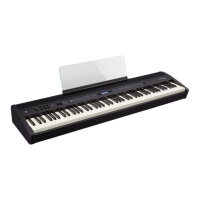4
°
Panel Descriptions
Damper Pedal
Use this pedal to sustain the sound. While this pedal is held down, notes will be sustained for an extended time even if you
release your ngers from the keyboard.
This reproduces the following features of an acoustic piano’s damper pedal.
5 A change in feel as you press the pedal, initially light but becoming heavier as you continue pressing (KPD-90 only)
5 Richness and spaciousness added by other strings sympathetically resonating with the sound of the notes you play
5 The distinctive decay added by “half-pedaling,” in which the core of the sound ends quickly while leaving only a rich
spaciousness and resonance
Sostenuto Pedal
The notes you are pressing when this pedal is depressed will be sustained.
Soft Pedal
This pedal is used to make the sound softer. Playing with the soft pedal depressed produces a sound that is not as strong
as when otherwise played with the equivalent strength. This is the same function as the left pedal of a grand piano. The
softness of the tone can be varied subtly by the depth to which you press the pedal.
Pedals (KPD-90 / RPU-3: sold separately)
* When operating the pedal, take care not to pinch your ngers between the moving part and the body of the unit. Pay special attention to this when using the unit where
children are present.
Attaching the Music Rest
1. Insert the music rest into the slit on the top of the piano.
RPU-3 (sold separately)
KPD-90 (sold separately)
[L] button
Turning the FP-60 On
1. Move the [Volume] slider all the way down to minimize the
volume.
Minimize the volume
2. Hold down the [L] button until the display shows “Roland Digital
Piano.”
The power turns on, and the tone buttons and other buttons
illuminate.
3. Move the [Volume] slider to adjust the volume.
Turning O the Power
1. Move the [Volume] slider all the way down to minimize the
volume.
2. Hold down the [L] button until the display shows “Don’t
disconnect the power.”
The piano is turned o.
* Never disconnect the power cord while the screen indicates
“Don’t disconnect the power.”
Concerning the Auto O function
The power to this unit will be turned o automatically after a
predetermined amount of time has passed since it was last used for
playing music, or its buttons or controls were operated (Auto O function).
If you do not want the power to be turned o automatically, disengage the
Auto O function (p. 24).
5 Any settings that you are in the process of editing will be lost when the
power is turned o. If you have any settings that you want to keep, you
should save them beforehand (p. 27).
5 To restore power, turn the power on again.
Front Panel
This is where you operate the piano by
selecting the items
shown in the display.
page
6
Headphone Jacks
Connect headphones (separately sold) here.

